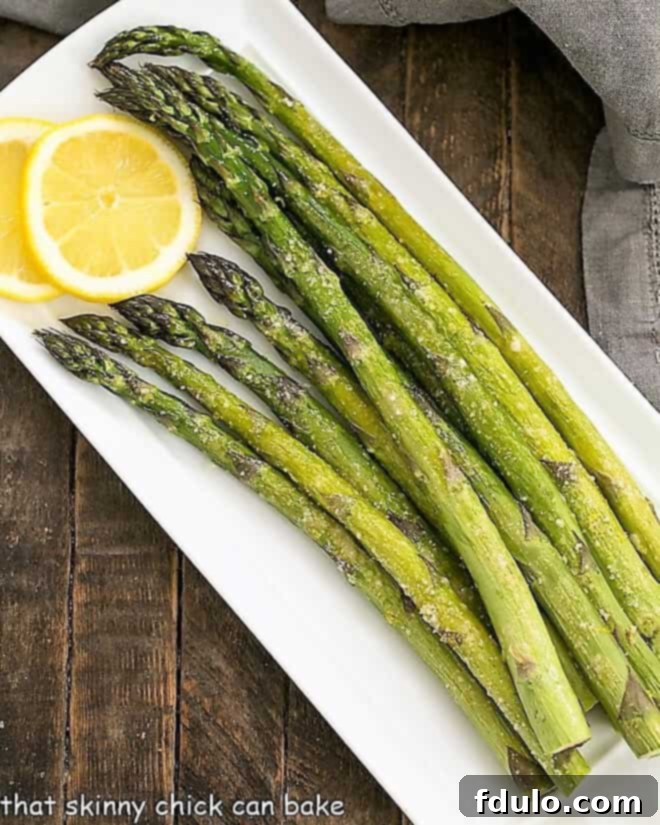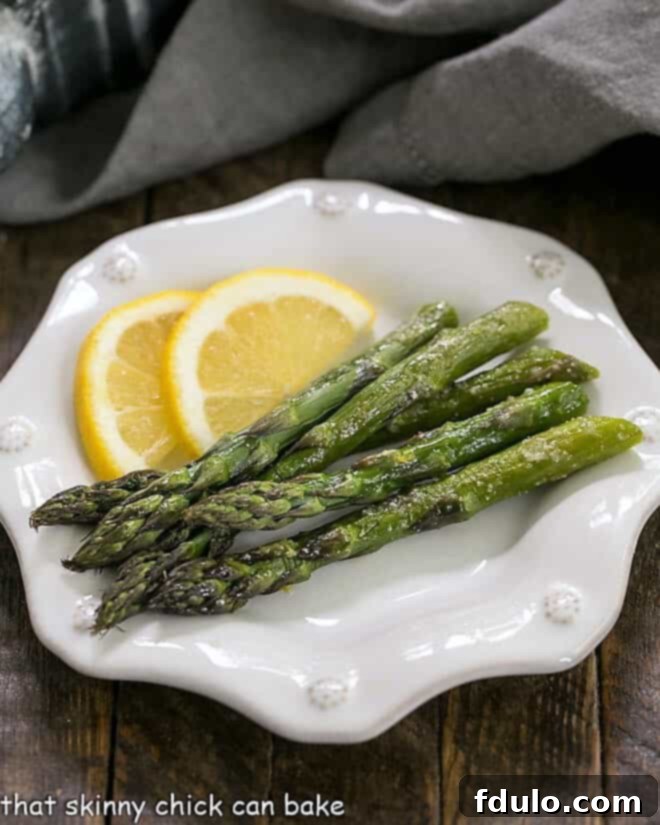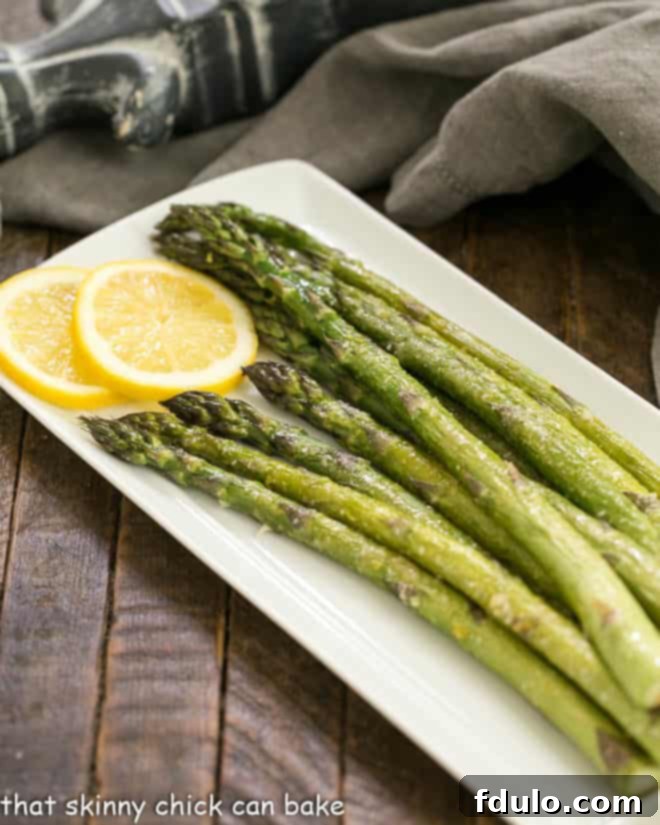This Easy Oven Roasted Asparagus recipe is an absolute game-changer, perfect for a quick, elegant, and incredibly flavorful side dish, especially when fresh, seasonal asparagus is at its peak! Forget bland, soggy steamed vegetables; roasting unlocks a depth of flavor that will make this vibrant green spear a staple at your dinner table.
Prepare to elevate your weeknight meals and special occasions with minimal effort. This one-pan technique streamlines the entire process—from seasoning to cooking and, most importantly, cleanup. It’s a deliciously simple method that truly celebrates the natural sweetness and delicate earthiness of asparagus, transforming it into a craveable vegetable that even picky eaters will enjoy. Whether you’re a seasoned chef or a kitchen novice, mastering oven-roasted asparagus is a culinary win you won’t regret.

Why Oven Roasted Asparagus Reigns Supreme
For years, many of us fell into the trap of steaming or boiling asparagus, resulting in a muted flavor and often a lackluster, watery texture. While these methods are quick, they often leach out the delicate nutrients and vibrant taste that make asparagus so special. Roasting, on the other hand, is a culinary revelation, especially for this elegant vegetable.
Here’s why roasting is the superior method for preparing asparagus:
- Intensified Flavor: Unlike steaming or boiling, which can dilute flavors, roasting concentrates the natural sugars and juices within the asparagus. This process caramelizes the exterior slightly, creating a richer, sweeter, and more complex flavor profile that is simply irresistible. You’ll truly taste the asparagus, not just the water it was cooked in.
- Perfect Texture: Roasting delivers that ideal tender-crisp texture. The spears become wonderfully tender on the inside with a slight snap, while the tips often achieve a delightful, slightly crispy char. It’s a texture contrast that makes every bite exciting.
- Remarkable Simplicity: This method requires minimal hands-on time. Once seasoned and spread on a baking sheet, the oven does all the hard work. It’s a truly one-pan wonder, translating to less fuss in the kitchen and significantly easier cleanup.
- Versatility: Roasted asparagus pairs beautifully with almost any meal, from a simple grilled chicken breast to a gourmet steak or a hearty pasta dish. It’s a versatile side that can be seasoned in countless ways to complement your main course.
- Nutrient Retention: While cooking generally impacts nutrient levels, dry-heat cooking methods like roasting can often preserve more water-soluble vitamins compared to boiling, where nutrients can escape into the cooking water.
Once you experience the transformative power of roasting, you’ll likely find, as many do, that almost every vegetable tastes better roasted! If you love roasted veggies, you must also try these Honey Balsamic Roasted Carrots—they’re absolutely terrific and another testament to the magic of oven cooking!
Key Ingredients for Succulent Roasted Asparagus
Crafting the perfect roasted asparagus requires just a few simple, high-quality ingredients. Here’s a deeper dive into what you’ll need and why each component matters for the best results:
- Fresh Asparagus: The star of our show! Look for vibrant green spears with tight, closed tips. We’ll discuss how to choose and prep them in detail below. Remember to trim the tough, woody ends before cooking; they can be fibrous and unpleasant to eat.
- Olive Oil: A good quality extra virgin olive oil is essential. It helps conduct heat, preventing the asparagus from drying out while promoting that beautiful caramelization. It also provides a lovely base flavor. You might need slightly more or less depending on the thickness of your asparagus spears and the quantity you’re roasting.
- Kosher Salt: This coarse-grained salt is perfect for seasoning roasted vegetables. It adheres well to the surface and provides a balanced salinity without being overly sharp. Adjust to your taste, remembering that a little salt truly brings out the natural sweetness of the asparagus.
- Garlic Powder: A touch of garlic powder adds a subtle aromatic depth that complements asparagus beautifully without overpowering its delicate flavor. It’s convenient and ensures even distribution.
- Fresh Lemon Zest: This is a game-changer! Always opt for fresh lemon zest, not the dried version found in the spice aisle. The bright, fragrant oils in fresh zest infuse the asparagus with a delightful citrusy lift that truly makes the flavors pop. It adds a layer of freshness that can’t be replicated.
- Parmesan Cheese: For an irresistible finish, grate some high-quality Parmigiano Reggiano. Its salty, nutty, umami notes melt beautifully onto the hot asparagus, adding a savory richness. Please, for the best flavor, avoid the pre-grated green can varieties from the grocery shelves; freshly grated makes all the difference.
These ingredients, while simple, work in harmony to create a truly unforgettable side dish. Don’t be afraid to adjust quantities to your personal preference; cooking is, after all, an art!

Mastering the Art of Oven Roasted Asparagus
While this recipe is incredibly simple, a few expert tips can elevate your roasted asparagus from good to absolutely perfect every single time. Pay attention to these details for the best possible results:
- Adjust Roasting Time for Spear Thickness: This is arguably the most crucial tip. Asparagus spears vary significantly in diameter with every purchase, from pencil-thin to thick jumbo stalks. Consequently, you must adjust your roasting time with each batch. Typically, at 425ºF (220ºC), it takes about 12-15 minutes until your asparagus is perfectly tender-crisp. However, thin spears can be finished in as little as 8-9 minutes, while very thick ones might need up to 18-20 minutes. Keep an eye on them!
- The Essential Trio: At its core, only three main ingredients are truly needed for delicious roasted asparagus: the asparagus itself, quality olive oil, and kosher salt. Everything else, such as freshly ground black pepper, a touch of garlic powder, fresh lemon zest, and grated Parmesan cheese, enhances the flavor but is ultimately optional. Feel free to customize based on your taste and what you have on hand.
- Effortless Cleanup Technique: To ensure an easy cleanup, which is always a bonus, line your rimmed baking sheet with foil or parchment paper before spreading the asparagus spears. Drizzle generously with olive oil, then gently shake the pan back and forth to ensure every spear is evenly coated with oil. This creates a barrier for the seasonings to adhere to and promotes even cooking. Then, simply season and roast.
- Avoid Overcrowding the Pan: For truly roasted (not steamed) asparagus, ensure the spears are spread in a single layer with a little space between them on the baking sheet. If the pan is too crowded, moisture released from the asparagus will steam rather than roast, leading to a softer, less flavorful result. If you’re cooking a large batch, use two baking sheets.
- Flavor Alternatives and Toppings: The beauty of roasted asparagus lies in its versatility. Once you’ve mastered the basic recipe, feel free to experiment with various seasonings and topping alternatives:
- Soy Sauce: For an umami kick, add a dash of soy sauce (remember to decrease your kosher salt when using).
- Butter: A pat of butter or a drizzle of melted brown butter adds a rich, luxurious touch.
- Buttered Bread Crumbs: Toss with toasted, buttered bread crumbs for extra crunch and texture.
- Balsamic Vinegar: A drizzle of balsamic vinegar or a balsamic glaze after roasting offers a sweet and tangy counterpoint.
- Lemon Juice: A squeeze of fresh lemon juice just before serving brightens all the flavors.
- Nuts: Toasted slivered almonds or pine nuts provide a delightful crunch.
- Bacon: Crumbled crispy bacon is always a welcome addition for a salty, smoky flavor.
- Fresh Herbs: Finish with a sprinkle of fresh chopped herbs like parsley, dill, chives, or thyme for added fragrance and color.
By following these expert tips, you’ll consistently achieve perfectly roasted asparagus that is tender, flavorful, and a delight to serve.
From Market to Oven: Your Guide to Perfect Asparagus Preparation
The journey to perfect roasted asparagus begins long before it hits the oven. Proper selection and preparation are key to ensuring delicious results every time. Let’s delve into how to choose the best fresh asparagus and prepare it for roasting.
How to Choose the Best Fresh Asparagus
Selecting the freshest asparagus is crucial for flavor and texture. Here’s what to look for when you’re at the market:
- Buy In Season: While asparagus is now available year-round, its peak season is typically April to June in many regions. Buying it in season often guarantees the best flavor, tenderness, and price.
- Vibrant Appearance: Look for spears that are bright green, or even purple-tinged, from tip to base. Avoid any with dull, yellowish, or discolored patches.
- Firm and Plump Stems: The stems should feel firm and plump, not rubbery or limp. Give them a gentle squeeze; they should be rigid and full of moisture, indicating freshness. Any wrinkles or softness in the stems means they’re past their prime and will likely be fibrous and less flavorful.
- Tight, Closed Tips: Focus on the tips, as they are a prime indicator of freshness. They should be vibrant green or purple, tightly closed, and compact. As asparagus ages, the tips start to splay open, become soft, or even mushy. Do not buy spears with soft, slimy, or open tips!
- Uniform Thickness (Optional): While not always possible, selecting spears of similar thickness can help ensure more even cooking. If you have a mix, you might need to separate them during roasting to pull the thinner ones out earlier.
How to Prep Asparagus for Roasting
Proper preparation ensures your asparagus roasts perfectly and tastes its best:
- Trimming the Woody Ends: Asparagus stems have a naturally woody, fibrous end that is tough and unpleasant to eat. There are a few ways to remove this:
- The Snap Method: Hold an asparagus spear with both hands, one near the bottom and one further up the stalk. Bend the spear gently until the tough end naturally snaps off. The asparagus will break at the point where the woody part meets the tender part. While intuitive, this can sometimes lead to more waste if the spear breaks too high up.
- The Knife Method: For less waste and a cleaner look, you can line up all your asparagus spears on a cutting board. Identify the natural breaking point on one spear (using the snap method as a guide, or by feeling for the firm-to-tender transition). Then, simply trim all the other spears at the same length with a sharp knife.
- The Dorie Greenspan Method: For thicker spears, especially, culinary expert Dorie Greenspan recommends using a vegetable peeler to remove the fibrous outer coating at the bottom end of the spears (above the snapped/trimmed end). This ensures even tenderness throughout the entire spear.
- Rinse and Dry Thoroughly: After trimming, make sure to rinse your asparagus spears under cold running water to remove any dirt or grit. Then, and this is crucial for roasting, pat the spears thoroughly dry with a clean, absorbent dish towel or paper towels. Any excess moisture on the asparagus will cause it to steam in the oven instead of roast, preventing that desirable caramelization and crisp-tender texture. Dry spears mean a truly roasted result!
Optimal Storage for Long-Lasting Freshness
Keeping asparagus fresh for as long as possible after purchase is essential to enjoying its vibrant flavor and tender texture. Improper storage can quickly lead to limp, sad spears. Here’s how you should store asparagus to maximize its shelf life:
How Should You Store Asparagus to Keep it Fresh?
The main challenge with storing asparagus is to keep the delicate tips dry while ensuring the stem ends remain moist and hydrated. There are a couple of highly effective methods:
- The “Flower Bouquet” Method (Recommended for longer storage):
- When you get home, trim about an inch off the bottom ends of the asparagus spears.
- Stand the trimmed spears upright in a wide-mouth jar or a drinking glass.
- Add about an inch or less of cold water to the bottom of the jar, just enough to cover the cut ends.
- Loosely cover the tips of the asparagus with a plastic produce bag or plastic wrap. This creates a humid environment for the tips while allowing some air circulation.
- Place the jar in the refrigerator.
This method allows the asparagus to continue drawing water up its stalks, keeping it crisp and hydrated. Stored this way, very fresh asparagus can last for 5-7 days, sometimes even longer.
- The Damp Paper Towel Method (Good for shorter storage):
- Trim the woody ends of the asparagus spears.
- Dampen a few paper towels and wrap them around only the trimmed ends of the asparagus.
- Place the asparagus (with the damp paper towels around the ends) into a plastic bag or a resealable produce bag.
- Alternatively, place them directly into the crisper drawer of your refrigerator, ensuring the tips are covered with a paper bag, not a plastic bag, to minimize spoiling and prevent moisture buildup around the tips.
With either method, asparagus should keep for 3-4 days if it was very fresh when purchased. Always check the tips and stems for firmness before cooking.
Serving Suggestions and Perfect Pairings
Roasted asparagus is incredibly versatile and makes a fantastic accompaniment to a wide variety of dishes. Its bright, slightly sweet, and savory flavor profile complements many main courses. Here are some ideas for how to serve your perfectly roasted asparagus:
- Protein Powerhouses: It’s a classic pairing with grilled or roasted chicken, pan-seared fish (salmon, cod, halibut), succulent steak, pork tenderloin, or lamb chops. The freshness of the asparagus cuts through the richness of meats beautifully.
- Brunch Favorite: Add it to a quiche, frittata, or serve alongside scrambled eggs and bacon for an elevated brunch experience.
- Pasta Dishes: Toss it into a light pasta primavera or serve it alongside a creamy lemon pasta. Its green crunch adds great texture.
- Grain Bowls & Salads: Chop it up and add it to warm grain bowls with quinoa or farro, or incorporate it into a refreshing spring salad for added depth and nutrition.
- Simple & Elegant: Sometimes, less is more. Serve it simply with a squeeze of fresh lemon, a sprinkle of flaky sea salt, or a drizzle of good quality balsamic glaze as a light appetizer or part of a vegetarian meal.
Explore More Delicious Side Dishes
If you loved this easy oven-roasted asparagus recipe, you’ll definitely want to try some of these other fantastic side dish ideas to complement your meals:
- 4th of July Side Dishes from Cooking on the Ranch
- Green Bean and Bacon Bundles
- Roasted Asparagus with Balsamic Brown Butter
- Asian Stir-Fried Asparagus
- Mexican Corn Salad
- Summer Vegetable Salad
- Strawberry Bacon Brie Salad
- For even more inspiration, browse our collection of Side Dish Recipes.
Stay in touch and discover more delicious recipes through social media @ Instagram, Facebook, and Pinterest. Don’t forget to tag me when you try one of my recipes! And if you love the results, please give it a 5-star rating in the recipe card below—your feedback helps others find and enjoy these recipes too!

Easy Oven Roasted Asparagus Recipe
5 minutes
15 minutes
20 minutes
4 servings
An easy, tasty way to cook asparagus.
Ingredients
- 1 pound fresh asparagus, ends trimmed
- 1 tablespoon olive oil (you may need more if your spears are thin)
- ¼-½ teaspoon kosher salt
- ½-1 teaspoon freshly grated lemon zest
- 2 or more pinches garlic powder
- 1 ½ tablespoons Parmesan cheese
Instructions
- Preheat oven to 425 degrees F (220 C).
- Line a rimmed sheet pan with foil or parchment paper for easy cleanup. Spread out asparagus in a single layer on the pan, ensuring not to overcrowd it.
- Drizzle asparagus evenly with olive oil. Gently tilt and shake the pan back and forth to ensure all the spears are lightly coated in oil.
- Evenly sprinkle with kosher salt, fresh lemon zest, garlic powder, and then the grated Parmesan cheese.
- Bake for 12 to 15 minutes, or until the spears are tender when pierced with a sharp knife and slightly caramelized. Thin spears may finish in 8-10 minutes, while thicker ones might take up to 20 minutes.
Notes
Adjust seasonings as needed depending on the size of your asparagus and your personal preference. For a stronger lemon flavor, you can add a squeeze of fresh lemon juice after roasting.
Roasting time will be longer for thick spears and shorter for skinny spears. Very thin spears may be fully cooked in 8-10 minutes, while jumbo spears could take up to 18-20 minutes. Always test for desired tenderness.
Recommended Kitchen Tools
As an Amazon Associate and member of other affiliate programs, I earn from qualifying purchases.
- Santoku Knife
- OXO Cutting Board
- USA Pan Bakeware Half Sheet Pan
Nutrition Information:
Yield:
4
Serving Size:
1
Amount Per Serving:
Calories: 64Total Fat: 4gSaturated Fat: 1gTrans Fat: 0gUnsaturated Fat: 3gCholesterol: 2mgSodium: 451mgCarbohydrates: 5gFiber: 2gSugar: 1gProtein: 3g
HOW MUCH DID YOU LOVE THIS RECIPE?
Please leave a comment on the blog or share a photo on Pinterest

